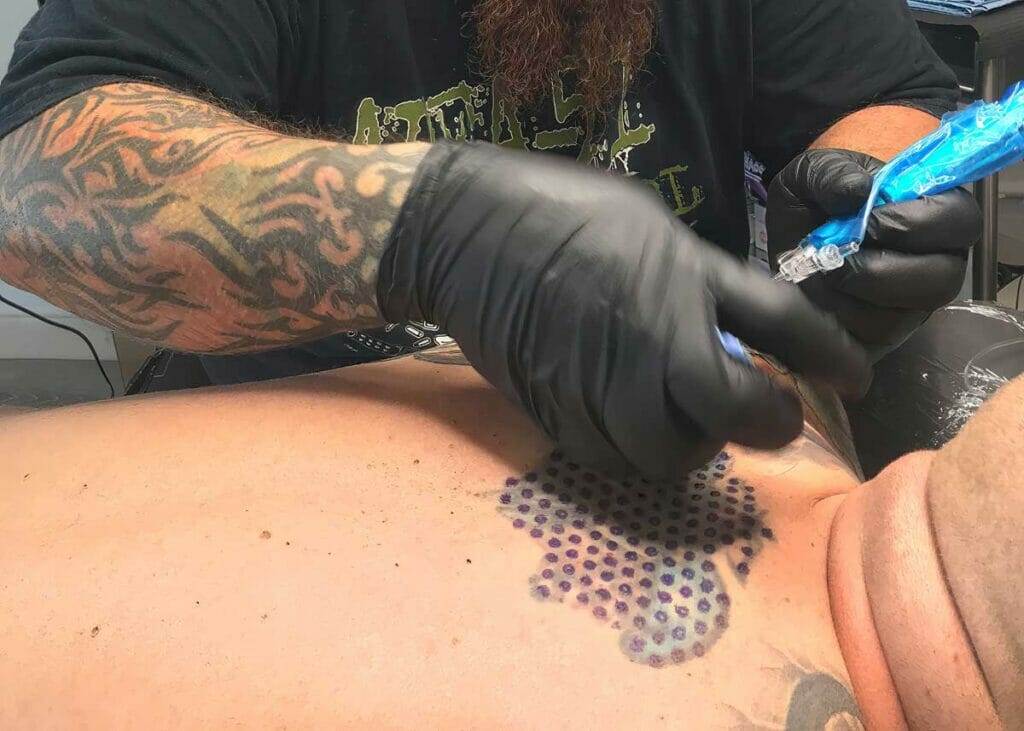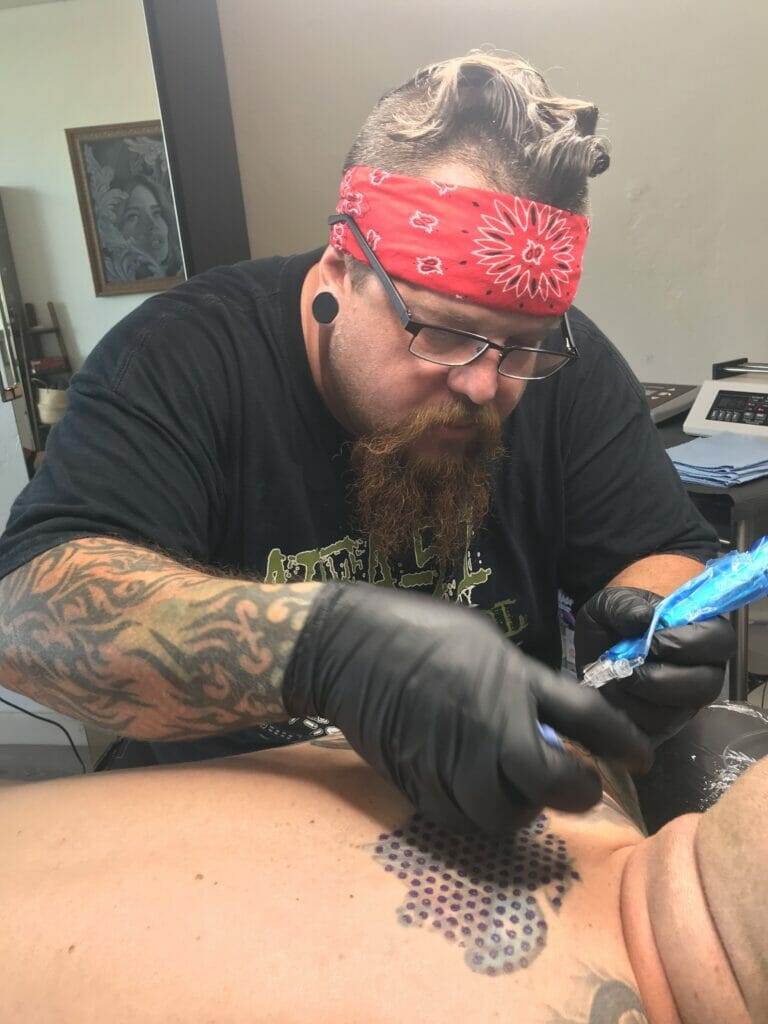In recent years, there has been a significant increase in the demand for non-laser tattoo removal methods. While laser tattoo removal has long been the go-to option for those looking to remove unwanted tattoos, many people are now opting for alternative methods. This growing popularity can be attributed to a variety of factors, including the desire for less painful and more affordable options, as well as the increasing availability of non-laser tattoo removal services.
One of the main reasons why people are choosing non-laser tattoo removal methods is the desire for a less painful experience. Laser tattoo removal can be quite uncomfortable, with many patients describing it as feeling like a rubber band being snapped against the skin. Non-laser methods, on the other hand, tend to be less painful and more tolerable for most individuals. This is particularly appealing to those with low pain thresholds or sensitive skin.
Another factor contributing to the rise in non-laser tattoo removal is cost. Laser tattoo removal can be quite expensive, with multiple sessions often required to achieve satisfactory results. Non-laser methods, on the other hand, are generally more affordable and can often be completed in fewer sessions. This makes them a more accessible option for those on a budget or who are looking for a quicker solution.
Understanding the Different Types of Non-Laser Tattoo Removal Methods
There are several different non-laser tattoo removal methods available today, each with its own unique approach to removing unwanted tattoos. These methods include chemical tattoo removal, microdermabrasion, saline solution, cryosurgery, natural ingredients, and TCA tattoo removal.
Chemical tattoo removal involves the use of acids or other chemicals to break down the ink pigments in the skin. This method typically involves applying a chemical solution to the tattooed area and allowing it to penetrate the skin and break down the ink particles. Over time, the tattoo fades as the ink is gradually removed from the body.
Microdermabrasion for tattoo removal is a process that involves using a handheld device to exfoliate the skin and remove the top layers of dead skin cells. This method can help to fade tattoos by gradually removing the ink pigments from the skin’s surface. However, it is important to note that microdermabrasion is not as effective as other non-laser methods and may require multiple sessions to achieve satisfactory results.
Saline solution is another non-laser tattoo removal method that involves injecting a saline solution into the tattooed area. The saline solution works to break down the ink pigments and flush them out of the body. This method is generally considered to be safe and effective, although multiple sessions may be required to achieve desired results.
Cryosurgery is a cold approach to tattoo removal that involves freezing the tattooed area with liquid nitrogen or another freezing agent. The extreme cold causes the ink pigments to break apart, allowing the body to naturally eliminate them over time. Cryosurgery is generally considered to be an effective method for tattoo removal, although it may cause some discomfort during the freezing process.
Non-laser tattoo removal using natural ingredients involves applying natural substances, such as lemon juice or aloe vera, to the tattooed area in order to break down the ink pigments. While this method may be appealing to those looking for a more natural approach, it is important to note that it may not be as effective as other non-laser methods and may require multiple applications over an extended period of time.
TCA tattoo removal, also known as trichloroacetic acid tattoo removal, is a chemical peel for tattoos that involves applying a solution containing TCA to the tattooed area. The TCA works to break down the ink pigments in the skin, causing them to fade over time. This method can be effective, but it is important to note that it can also cause skin irritation and may require multiple sessions to achieve desired results.
Chemical Tattoo Removal: How it Works and Its Pros and Cons
Chemical tattoo removal is a non-laser method that involves the use of acids or other chemicals to break down the ink pigments in the skin. This method typically involves applying a chemical solution to the tattooed area and allowing it to penetrate the skin and break down the ink particles. Over time, the tattoo fades as the ink is gradually removed from the body.
One of the main advantages of chemical tattoo removal is that it can be a relatively quick and effective method for removing unwanted tattoos. The chemical solution works to break down the ink pigments in the skin, allowing them to be naturally eliminated by the body. This can result in significant fading or complete removal of the tattoo over time.
Another advantage of chemical tattoo removal is that it can be less painful than laser tattoo removal. While there may still be some discomfort associated with the application of the chemical solution, it is generally less intense than the sensation experienced during laser treatments. This can make chemical tattoo removal a more tolerable option for those with low pain thresholds or sensitive skin.
However, there are also some potential drawbacks to consider when it comes to chemical tattoo removal. One of the main concerns is the risk of skin irritation or damage. The chemicals used in this method can be harsh on the skin and may cause redness, swelling, or other adverse reactions. It is important to follow proper aftercare instructions and consult with a professional to minimize these risks.
Additionally, chemical tattoo removal may not be suitable for all types of tattoos or all skin types. Some colors or types of ink may be more resistant to chemical removal, making it more difficult to achieve desired results. It is important to consult with a professional to determine if chemical tattoo removal is a suitable option for your specific tattoo and skin type.
Microdermabrasion for Tattoo Removal: Is it Effective?

Microdermabrasion is a non-laser tattoo removal method that involves using a handheld device to exfoliate the skin and remove the top layers of dead skin cells. This method can help to fade tattoos by gradually removing the ink pigments from the skin’s surface. However, it is important to note that microdermabrasion is not as effective as other non-laser methods and may require multiple sessions to achieve satisfactory results.
One of the main advantages of microdermabrasion for tattoo removal is that it is a relatively gentle and non-invasive method. The handheld device used in this process gently exfoliates the skin, removing the top layers of dead skin cells and gradually fading the tattoo. This can be a more tolerable option for those with sensitive skin or those who are looking for a less painful alternative to laser tattoo removal.
Another advantage of microdermabrasion is that it can be a more affordable option compared to laser tattoo removal. While multiple sessions may still be required to achieve desired results, the overall cost of microdermabrasion is often lower than that of laser treatments. This can make it a more accessible option for those on a budget or who are looking for a more cost-effective solution.
However, it is important to note that microdermabrasion may not be as effective as other non-laser methods for tattoo removal. This method primarily works by removing the top layers of dead skin cells, which may not penetrate deep enough to fully eliminate the ink pigments in the skin. As a result, multiple sessions may be required to achieve satisfactory results, and complete removal of the tattoo may not be possible.
The Role of Saline Solution in Non-Laser Tattoo Removal
Saline solution is another non-laser tattoo removal method that involves injecting a saline solution into the tattooed area. The saline solution works to break down the ink pigments and flush them out of the body. This method is generally considered to be safe and effective, although multiple sessions may be required to achieve desired results.
One of the main advantages of saline solution tattoo removal is that it is a relatively safe and gentle method. The saline solution used in this process is similar to the body’s natural fluids, making it less likely to cause adverse reactions or skin irritation. This can make it a suitable option for those with sensitive skin or those who are concerned about potential side effects.
Another advantage of saline solution tattoo removal is that it can be an effective method for fading or removing unwanted tattoos. The saline solution works to break down the ink pigments in the skin, allowing them to be naturally eliminated by the body. This can result in significant fading or complete removal of the tattoo over time.
However, it is important to note that multiple sessions may be required to achieve desired results with saline solution tattoo removal. The number of sessions needed will depend on factors such as the size and color of the tattoo, as well as individual factors such as skin type and healing ability. It is important to consult with a professional to determine the recommended number of sessions for your specific tattoo.
Cryosurgery: A Cold Approach to Tattoo Removal
Cryosurgery is a non-laser tattoo removal method that involves freezing the tattooed area with liquid nitrogen or another freezing agent. The extreme cold causes the ink pigments to break apart, allowing the body to naturally eliminate them over time. Cryosurgery is generally considered to be an effective method for tattoo removal, although it may cause some discomfort during the freezing process.
One of the main advantages of cryosurgery for tattoo removal is that it can be a relatively quick and effective method. The freezing process causes the ink pigments in the skin to break apart, allowing them to be naturally eliminated by the body. This can result in significant fading or complete removal of the tattoo over time.
Another advantage of cryosurgery is that it can be a less painful option compared to laser tattoo removal. While there may still be some discomfort associated with the freezing process, it is generally less intense than the sensation experienced during laser treatments. This can make cryosurgery a more tolerable option for those with low pain thresholds or sensitive skin.
However, it is important to note that cryosurgery may not be suitable for all types of tattoos or all skin types. Some colors or types of ink may be more resistant to freezing, making it more difficult to achieve desired results. It is important to consult with a professional to determine if cryosurgery is a suitable option for your specific tattoo and skin type.
Non-Laser Tattoo Removal Using Natural Ingredients
Non-laser tattoo removal using natural ingredients involves applying natural substances, such as lemon juice or aloe vera, to the tattooed area in order to break down the ink pigments. While this method may be appealing to those looking for a more natural approach, it is important to note that it may not be as effective as other non-laser methods and may require multiple applications over an extended period of time.
One of the main advantages of non-laser tattoo removal using natural ingredients is that it can be a more gentle and non-invasive method. Natural substances such as lemon juice or aloe vera are generally safe for use on the skin and are less likely to cause adverse reactions or skin irritation. This can make it a suitable option for those with sensitive skin or those who are looking for a more natural alternative to laser tattoo removal.
Another advantage of using natural ingredients for tattoo removal is that they are often readily available and affordable. Many natural substances can be found in everyday household items or purchased at a low cost from local stores. This can make non-laser tattoo removal using natural ingredients a more accessible option for those on a budget or who are looking for a more cost-effective solution.
However, it is important to note that non-laser tattoo removal using natural ingredients may not be as effective as other methods for fading or removing unwanted tattoos. Natural substances may not penetrate deep enough into the skin to fully break down the ink pigments, resulting in slower or less noticeable results. Additionally, multiple applications over an extended period of time may be required to achieve desired results.
TCA Tattoo Removal: A Chemical Peel for Tattoos
TCA tattoo removal, also known as trichloroacetic acid tattoo removal, is a chemical peel for tattoos that involves applying a solution containing TCA to the tattooed area. The TCA works to break down the ink pigments in the skin, causing them to fade over time. This method can be effective, but it is important to note that it can also cause skin irritation and may require multiple sessions to achieve desired results.
One of the main advantages of TCA tattoo removal is that it can be an effective method for fading or removing unwanted tattoos. The TCA solution works to break down the ink pigments in the skin, allowing them to be naturally eliminated by the body. This can result in significant fading or complete removal of the tattoo over time.
Another advantage of TCA tattoo removal is that it can be a relatively quick and affordable option compared to laser tattoo removal. While multiple sessions may still be required to achieve desired results, the overall cost of TCA treatments is often lower than that of laser treatments. This can make it a more accessible option for those on a budget or who are looking for a more cost-effective solution.
However, it is important to note that TCA tattoo removal can cause skin irritation and may require proper aftercare to minimize potential side effects. The TCA solution is a strong acid that can cause redness, swelling, or other adverse reactions if not used properly. It is important to follow the instructions provided by a professional and consult with them to determine the recommended number of sessions for your specific tattoo.

The Effectiveness of Non-Laser Tattoo Removal Compared to Laser Removal
When it comes to comparing the effectiveness of non-laser tattoo removal methods to laser removal, it is important to consider several factors. These factors include the type and color of the tattoo, the individual’s skin type and healing ability, and the specific method being used.
In general, laser tattoo removal is considered to be the most effective method for completely removing unwanted tattoos. Laser treatments work by targeting the ink pigments in the skin and breaking them apart with high-intensity light energy. This allows the body to naturally eliminate the ink over time. Laser removal can be particularly effective for tattoos with dark ink or those that are located deeper in the skin.
However, non-laser tattoo removal methods can also be effective for fading or partially removing tattoos. The effectiveness of these methods will depend on factors such as the type and color of the tattoo, as well as individual factors such as skin type and healing ability. Some non-laser methods may be more effective for certain types of tattoos or skin types, while others may be less effective.
It is important to consult with a professional to determine which non-laser method is most suitable for your specific tattoo and skin type. They will be able to assess your individual needs and recommend the most appropriate treatment option for you . Some common non-laser tattoo removal methods include dermabrasion, chemical peels, and tattoo removal creams. Dermabrasion involves using a high-speed rotating brush to remove the top layers of skin, while chemical peels use acid solutions to exfoliate the skin. Tattoo removal creams work by breaking down the ink particles in the skin. However, the effectiveness of these methods can vary depending on factors such as the size and color of the tattoo, as well as the depth of the ink. Therefore, seeking professional advice is crucial to ensure that you choose the safest and most effective non-laser method for your specific situation.







